Main Takeaways
- This article discusses the main upgrades of Ethereum 2.0.
- The future of Ethereum after The Merge is also covered.

Major upgrades and the future of Ethereum
Introduction
Ethereum is the trendsetter in the blockchain world. All the biggest trends, including ICO, DeFi, and NFT, originated from Ethereum. Despite being the pioneer, Ethereum’s users were leaving the network due to the high gas fees and poor scalability. To address these problems, Ethereum 2.0 was introduced, setting the stage for a more robust and scalable ecosystem that better supports its growing user base and applications.
The Transition from Proof of Work to Proof of Stake
The most significant change in Ethereum 2.0 must be the transition from a Proof of Work (PoW) to a Proof of Stake (PoS) consensus mechanism.
In the PoW system, miners use computational power to solve complex mathematical puzzles to validate transactions and secure the network. However, this method is energy-intensive and negatively affects the environment while being incredibly inefficient.
With PoW, transaction processing is like a race. Everyone starts at the same time and runs the same distance, but whoever gets first place wins all. It requires miners to constantly upgrade their system to become the winner, or else they are wasting their computational resources for nothing. Before The Merge, the TPS (transaction per second) of Ethereum was 30. Take notice that at that time, the theoretical maximum TPS of Solana was 65,000.
By transitioning to PoS, Ethereum replaces miners with validators who stake (lock up) their ETH as collateral. These validators are randomly chosen to validate transactions, depending on the amount of ETH they have staked. This shift has resolved the long-established problems of Ethereum:
- Energy Efficiency: PoS requires much less energy as it does not require powerful mining hardware.
- Accessibility: The barrier to becoming a validator is much lower than becoming a miner. Instead of spending money on a huge computer system, users just need to buy 32 ETH and stake them. This makes it so much easier for more people to participate in securing the Ethereum network.
- Security: The amount of ETH that validators stake can be subtracted if they act maliciously. This ensures no validator can compromise the security of the network.
The transition to PoS also makes Ethereum more sustainable and environmentally friendly, aligning with global efforts to reduce carbon footprints.

Ethereum’s transition from PoW to PoS
Sharding: Enhancing Speed and Efficiency
The old Ethereum processes transactions one by one in a sequential order. This means whether there are 10 or 1000 transactions, Ethereum still completes an order at a time, causing frequent network congestion. In these scenarios, users have to pay higher gas fees for slower transaction speeds. This happens daily for a famous blockchain like Ethereum.
Sharding is a pivotal feature introduced with Ethereum 2.0, aiming to improve transaction throughput. With sharding, the Ethereum blockchain is divided into smaller “shards,” with each shard functioning like a mini blockchain. These shards are capable of processing transactions and smart contracts independently, thus enhancing Ethereum in many aspects.
- Scalability: Sharding significantly improves Ethereum’s scalability by processing multiple transactions at a time, reducing network congestion.
- Lower Fees: The gas fees applied on every transaction are lower, as users are not forced to pay extra to have their transactions processed anymore.
Together with PoS, sharding is expected to make Ethereum 2.0 a much faster and more cost-effective network. Instead of just 30 TPS maximum, Ethereum can handle 20,000–100,000 TP. This, combined with the pioneering role in dApps, DeFi, and NFTs, keeps Ethereum a dominant blockchain in the crypto space and ensures its relevance in the future.
The Future of Ethereum: Danksharding
Danksharding is the next major upgrade for Ethereum 2.0. This approach eliminates the need to split Ethereum into multiple shards by combining all data into a unified structure. This makes data storage and transaction processing much more efficient.
To achieve this, Danksharding uses a system called data availability sampling (DAS), which allows nodes to verify data in “blobs” without needing to store all of it. Here’s a breakdown of these key terms:
- Blobs: Blobs are large chunks of temporary data that are essential for storing and transmitting transaction information but are kept separate from the core blockchain data. This setup reduces the burden on Ethereum’s main network and helps keep transaction costs lower.
- Rollups: Rollups are Layer 2 scaling solutions that bundle or “roll up” multiple transactions together and process them off the main Ethereum chain. Only the summary data is sent back to Ethereum, which increases transaction speed and reduces fees. Danksharding will further improve this system by enabling Ethereum to handle large volumes of rollup data efficiently.
With Danksharding, Ethereum will be able to easily support the heavy data requirements of rollups, lowering storage requirements for validators that only need to sample small pieces of data rather than storing everything. The upgrade promises huge scalability for Ethereum, enabling it to support thousands or even millions of transactions per second.
Moreover, it will reduce gas costs enormously, making transaction costs extremely cheap for users. This also allows lower hardware requirements to validate transactions, allowing more people to participate in securing the network and increasing decentralization and security.
Conclusion
Ethereum 2.0 is an overall upgrade of Ethereum, improving the scalability, energy efficiency, and security of the previous version. By employing Ethereum 2.0, this network has resolved its most longing problems, which are scalability and high fees. This blockchain will continue to be a key player and the pioneer in the blockchain space.
Share on Social Media:
